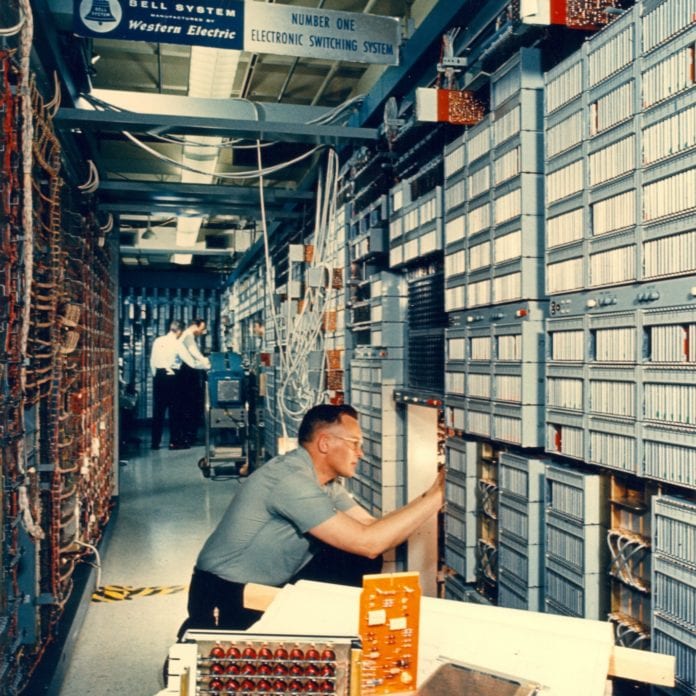Move to modern, virtualized networks sends legacy 1AESS switch to the AT&T archive
2017 has been a year of bidding farewell to some notable contributors to science and technology. The Cassini spacecraft reached the end of its mission and plunged into the atmosphere of Saturn. Verizon, after acquiring American Online, is shutting down AOL Instant Messenger. In Odessa, Tex., the last operational 1A ESS electronic switch was taken out of service in June and consigned to telecom history.
The 1A represented the first widespread use of primitive software and memory to provide telephone services, rather than the previous generation of noisy, electro-mechanical switches with many physically moving parts, according to Scott Mair, senior vice president of network planning and engineering for AT&T. An earlier model, the 1E electronic switch, was the first model to accomplish this, but it was the 1A that made it into broad use within telecom networks.

“The 1E was the first instance, but it was the 1A that took off and became the workhorse of the network,” said Mair. “It was the first time where software and memory was actually used in providing telephone service.” The 1E ESS was introduced in 1965 and had a 200 KHz processor, and needed 7 bays of equipment; the 1A trimmed that down to five.
“It was really novel for its time, really advanced for its time,” Mair said. The 1A ESS first appeared in the early 1970s, he said, and AT&T began putting them into its network around 1975 to 1976. The 1A far outdid its predecessor in capabilities, with a 1 MHz processor.
“It was really a revelation, because it expanded call processing – expanded the amount of calls that could be simultaneously handled,” Mair said. The 1A ESS had disk storage so that features could be added, and eventually was able to supported features like call waiting and three-way calling, speed dialing, and the ability to call “9” to dial out of a hotel or office building. Telephone systems had evolved from the early days of “party lines” with multiple households being served by a single telephone line, to single-household lines, so “people being able to do a phone call with three parties was something new,” Mair said.
Those features laid the groundwork for additional enhancements on the 1A, he added. In the mid-1980s, a new system of signal controlling was introduced that enabled services such as 1-800 services, collect calling, and faster call set-up.
Then there was the physical form of the machine itself: Mair described the 1A as “an elegant machine for its time,” with a distinctive hum and a reputation for running long and well. Some AT&T employees worked at the company for their entire careers and only worked with the 1A switches, Mair said, many of whom have recently retired from the company. “It was a labor of love for them, because they knew those machines inside and out,” Mair said. “You can’t say that about many machines, that they had real meaning to the people who worked on them.”
The last 1A switch to be pulled out of service in Odessa had been installed in 1978 – a far cry from the brave new world of virtual network machines that can wink in and out of existence.
“It was quite the machine, for that age,” said Mair. “It was running flawlessly – but time had passed it by.” What the 1A could do while taking up 2,000 square feet of space “you can do today on a server and software in a large broom closet.” The ability of modern telecom software and systems to be upgraded, to support the development and deployment of new services, to provide security and evolve very rapidly, Mair said, is “the difference between where we were then and where we are now.”
The 1E, Mair said, could handle the processing for about 65,000 telephone lines; the 1AESS switch was more advanced and could support 100,000 simultaneous lines and about 250,000 calls an hour. Networks today handle millions of calls at any given moment, he noted.
AT&T held a celebration when the last 1A ESS switch was taken out of the network in Odessa, Mair said, “to wish it well and thank that machine for its work and capabilities.” While the switch itself is being added to the AT&T archives in New Jersey – a place that was likened to the final warehouse scene in Raiders of the Lost Ark – Mair himself has a small souvenir of the 1A: one of

its memory cards, which would be unrecognizable as such to anyone who has grown up in the age of micro SD cards: a metal sheet about the size of a piece of letter-sized paper, with a series of magnetized metallic dots that carried the information to help the 1A work its magic.
“Most of our days are all looking forward,” Mair said. “So many days are all LTE and 5G and virtualization of the network, software, and building capabilties for the next five years. It’s nice to pause and look back.”

